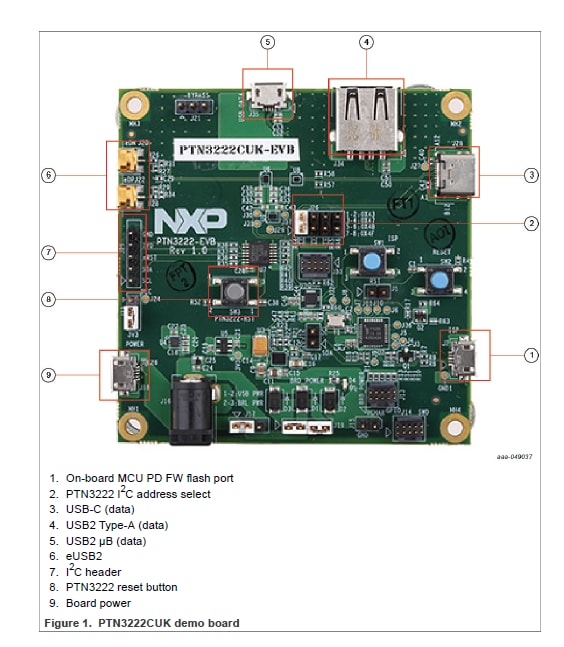- Analog Toolbox
- Getting Started with the PTN3222CUK-EVB Evaluation Board
Getting Started with the PTN3222CUK-EVB Evaluation Board
Contents of this document
-
Out of the Box
-
Get Hardware
-
Configure Hardware
Sign in to save your progress. Don't have an account? Create one.

Purchase your PTN3222CUK-EVB
1. Out of the Box
The NXP analog product development boards provide an easy-to-use platform for evaluating NXP products. The boards support a range of analog, mixed-signal and power solutions. They incorporate monolithic integrated circuits and system-in-package devices that use proven high-volume technology. NXP products offer longer battery life, a smaller form factor, reduced component counts, lower cost, and improved performance in powering state-of-the-art systems.
This page will guide you through the process of setting up and using the PTN3222CUK-EVB board.
2. Get Hardware
2.1 Board Features
- eUSB2 host repeater or peripheral repeater
- Board can be powered via a uB connector, or USB-C connector
- USB2 LS, FS and HS capable
- Supports USB2 Type-A, uB or USB-C connector
- PTN3222CUK I²C interface header
2.2 Board Description
PTN3222CUK is a one-port eUSB2 to USB2 redriver IC that performs translation between eUSB2 and USB2 signaling schemes. It is meant to be used in systems that have an eUSB2 interface on one side and a USB2 interface on the other side. It supports host-role only, device-role only or dual-role repeater function.
3. Configure Hardware
3.1 Configure Hardware
The PTN3222CUK-EVB can be configured to support eUSB2 host or eUSB2 device mode via port configuration command or via I²C. The demo board can be configured via jumpers to be powered from the DC barrel (5.0 V, 1.0 A or more), from a uB connector or from the type C connector, the factory default.
In host mode, the board can be selected to provide 5.0 V to the USB connectors, the type C connector. In device mode, the board can be selected to be powered from the uB connector.
As factory default, the board is configured as eUSB2 peripheral repeater and USB2 signals are routed to the USB-C connector. The board can be powered via the USB2 uB connector (J18) or USB-C connector (J28).
PTN3222CUK I²C SCL and SDA are routed to header J25.
PTN3222CUK eDP and eDN are routed to J22 and J20.
